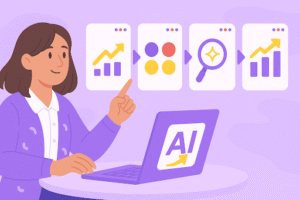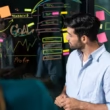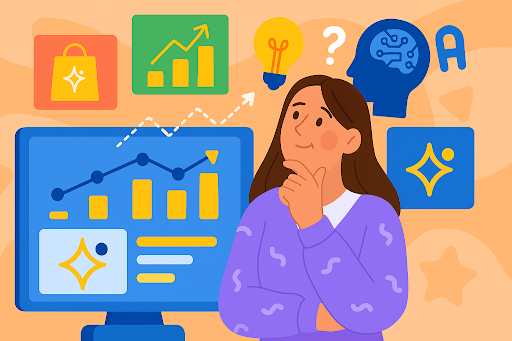Branding is always evolving. From minimalist logos to dynamic identities, what’s considered “modern” can shift within months. But what if you could see the next wave coming — before everyone else? With artificial intelligence (AI), predicting branding trends is no longer science fiction. It’s a data-driven possibility.
How Does AI Understand Branding?
AI doesn’t “see” style like a human. Instead, it breaks visuals into data — colors, shapes, fonts, layouts, and thousands of minute attributes. Using machine learning (ML) — a branch of AI that trains algorithms on large data sets — machines can detect patterns, compare them over time, and even make predictions about what’s coming next. This is the foundation behind every AI-powered logo maker, which uses these insights to generate designs that align with current trends and brand needs.
The key lies in trend forecasting models trained on historical branding data. These systems identify how brand visuals change across industries, platforms, and cultural shifts, then apply that learning to spot the signals of emerging trends.
Let’s unpack how this works — and how you can use it.
How AI Predicts Branding Trends: Step by Step

Step 1: Collecting Brand Data
Every prediction starts with a dataset. For branding trends, this usually includes:
- Logos and brand visuals from different time periods
- Social media brand content
- Website design archives
- Consumer reaction data (likes, shares, engagement)
Each data point tells part of the story. Together, they help AI track visual shifts and cultural signals.
Step 2: Feature Extraction
AI systems convert visual elements into measurable features:
- Color use: Warm vs. cool tones, saturation, contrast
- Typography: Serif or sans-serif, kerning, size dynamics
- Layout structure: Symmetry, whitespace, layering
- Logo shape and complexity: Geometric, abstract, or illustrative
These features allow AI to recognize not only what a brand looks like, but also how its style compares to others over time.
Step 3: Training the Model
Using supervised or unsupervised learning, the model analyzes how branding elements have changed year by year. For instance, it might learn that:
- Gradients became more popular between 2018–2021
- Serif fonts returned in luxury brands around 2022
- Muted color palettes gained traction in eco-conscious startups
Then, using time series forecasting or pattern recognition, the model can suggest what might trend next.
Step 4: Predicting Forward
Trained AI models can forecast style trajectories — not just visually, but contextually. By factoring in economic conditions, platform usage, or even generational taste (like Gen Z’s bold aesthetic), the AI can:
- Suggest which design styles will become dominant
- Recommend brand directions that align with rising consumer preferences
- Alert designers when a trend is reaching saturation
AI doesn’t predict trends with certainty, but it provides data-informed foresight to guide brand decisions.
Tools and Resources to Explore AI-Based Trend Forecasting
| Tool / Platform | Function |
| Google Vision API | Extracts visual features from images |
| Hugging Face Models | Hosts pre-trained transformers and vision AI |
| RunwayML | Creative tools with generative AI |
| OpenCV | Computer vision library for feature detection |
| TensorFlow / PyTorch | Building custom ML models |
| TimeGPT, Prophet | Forecasting tools for time-based trend modeling |
| Google Trends + Social Listening APIs | Tracks public interest and keyword shifts |
Combining visual feature data with behavioral data (search trends, social engagement) strengthens the accuracy of predictions.
Real-World Example: Predicting the Return of Bold Colors
In a recent internal study, a machine learning model was trained on:
- 10,000+ brand visuals from 2010–2023
- Metadata including industry, audience age, and country
- Social media engagement metrics
The AI discovered:
- Flat design peaked around 2017–2019
- Muted pastels grew in popularity during 2020–2021
- Bold, saturated colors began to rise again in 2022, often paired with nostalgic elements
By early 2024, the AI flagged a strong upward trend in 1990s-inspired maximalist palettes, which indeed began appearing in fashion, music, and tech branding shortly after.
This kind of foresight helps brands act early — and set trends, rather than follow them.
Can Humans Compete? AI vs. Traditional Forecasting
| Approach | Pros | Cons |
| AI Forecasting | Fast, scalable, data-driven | Requires clean data and technical setup |
| Human Forecasting | Context-aware, intuitive, creative | Slower, prone to bias or limited datasets |
| Hybrid Approach | Combines insight with automation | Still needs thoughtful integration |
AI is powerful — but not perfect. It’s best used as an augmentation tool to assist strategists and designers, not replace them.
Best Practices for Using AI in Branding Strategy
DO:
- Combine quantitative and qualitative inputs. Use AI trend signals alongside market research and audience feedback.
- Test before rollout. Use predicted styles in A/B testing or limited campaigns before committing.
- Keep the loop human. Designers should refine AI-driven ideas into brand-coherent expressions.
DON’T:
- Follow predictions blindly. A trend doesn’t mean every brand should follow it.
- Ignore nuance. AI may miss cultural subtleties or emerging micro-trends.
- Use outdated data. AI trained on last year’s visuals won’t catch what’s coming.
FAQ: Branding Forecasts Powered by AI
Can AI tell me exactly what my logo should look like next year?
Not exactly — but it can show you what directions are gaining momentum and what elements (like serif fonts or warm palettes) are returning to favor.
How often should I update trend models?
Every 6–12 months is ideal, especially if you’re working in fast-paced markets like tech, fashion, or digital services.
Do small businesses benefit from this too?
Absolutely. AI can help startups make data-informed branding decisions without expensive consulting.
Is this the same as using ChatGPT for brand ideas?
Not quite — ChatGPT helps with content and brainstorming, but predicting design trends requires visual data analysis, which is a different AI process.
Conclusion: From Guesswork to Foresight
Branding used to be guided by taste, intuition, and inspiration. While that creative spark still matters, AI introduces something new: clarity from complexity. It lets us learn from massive datasets, spot hidden shifts, and respond faster than ever before.
The next big trend isn’t just a matter of luck — it’s a matter of listening to data. And with AI, you now have the tools to do just that.
Article by Turbologo Experts
Learn more about design technology and future branding tools at Turbologo Blog




